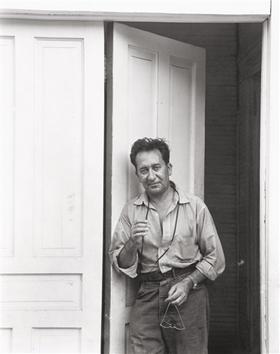
Harry Morey Callahan was an American photographer and educator. He taught at both the Institute of Design at the Illinois Institute of Technology in Chicago, and the Rhode Island School of Design in Providence.

Garry Winogrand was an American street photographer, known for his portrayal of U.S. life and its social issues in the mid-20th century. Photography curator, historian, and critic John Szarkowski called Winogrand the central photographer of his generation.

Aaron Siskind was an American photographer whose work focuses on the details of things, presented as flat surfaces to create a new image independent of the original subject. He was closely involved with, if not a part of, the abstract expressionist movement, and was close friends with painters Franz Kline, Mark Rothko, and Willem de Kooning.
John Pfahl was an American photographer.

Brian Ulrich is an American photographer known for his photographic exploration of consumer culture.
Linda Connor is an American photographer living in San Francisco, California. She is known for her landscape photography.
William Larson is an American photographer who has influenced the photographic world with conceptual pieces that examine the role of technology in art.
Barbara Crane was an American artist photographer born in Chicago, Illinois. Crane worked with a variety of materials including Polaroid, gelatin silver, and platinum prints among others. She was known for her experimental and innovative work that challenges the straight photograph by incorporating sequencing, layered negatives, and repeated frames. Naomi Rosenblum notes that Crane "pioneered the use of repetition to convey the mechanical character of much of contemporary life, even in its recreational aspects."
Joyce Neimanas is an American artist known for her unorthodox approach to photography and mixed-media works.
Daniel Traub is a New York City-based photographer and filmmaker. Much of his work focuses on border regions and marginalized communities.
Susan Rankaitis is an American multimedia artist working primarily in painting, photography and drawing. Rankaitis began her career in the 1970s as an abstract painter. Visiting the Art Institute of Chicago while in graduate school, she had a transformative encounter with the photograms of the artist László Moholy-Nagy (1895–1946), whose abstract works of the 1920s and 1940s she saw as "both painting and photography." Rankaitis began to develop her own experimental methods for producing abstract and conceptual artworks related both to painting and photography.
Ruth Thorne-Thomsen is an American photographer who resides in Philadelphia. Important collections of her work are held by the Philadelphia Museum of Art, the Nelson-Atkins Museum, and the Art Institute of Chicago. She was married to the photographer Ray K. Metzker until his death in 2014.
Robert Stiegler (1938–1990) was a Chicago filmmaker and photographer, whose work grew out of the approaches to photography and design taught at the Institute of Design (ID) in the 1960s and 1970s. His work is in the collections of the Museum of Modern Art in New York, the Art Institute of Chicago, the George Eastman House, the Museum of Contemporary Art in Chicago, and the University of Illinois Chicago. His films Traffic (1960), Capitulation (1965), Licht Spiel Nur 1 (1967), and Full Circle (1968) are housed at the Chicago Film Archives.
Gita Lenz was an American born New York photographer whose imagery ranged from the humanist to the abstract.
Deborah Bright is a 20th-century American photographer and artist, writer, and educator. She is particularly noted for her imagery and scholarship on queer desire and politics, as well as on the ideologies of American landscape photography. Her work is in the collections of the Smithsonian American Art Museum, the Fogg Art Museum, and the Whitney Museum of American Art. Bright's photographic projects have been exhibited internationally.
Nancy Floyd, born in Monticello, Minnesota in 1956, is an American photographer. Her photographic subjects mainly concern women and the female body during youth, pregnancy, and while aging. Her project She's Got a Gun comprises portraits of women and their firearms, which is linked to her Texas childhood. Floyd's work has been shown in 18 solo exhibitions and is held in the collections of the Museum of Contemporary Photography and the High Museum of Art. Floyd is a professor emeritus of photography at the Ernest G. Welch School of Art and Design at Georgia State University.
Jed Robert Fielding is an American street photographer, based in Chicago. His work has concentrated on the Italian cities of Rome and Naples, as well as Mexico City. He has published the monographs City of Secrets: Photographs of Naples (1997), Look at me: Photographs from Mexico City (2009), and Encounter: Photographs by Jed Fielding (2022).
Jess T. Dugan is an American portrait photographer and educator, living in St. Louis, Missouri. They are currently the 2020–2021 Henry L. and Natalie E. Freund Teaching Fellow at the Sam Fox School of Design & Visual Arts, Washington University in St. Louis.
Elaine O'Neil is an American fine art photographer. She studied at the Illinois Institute of Technology and earned her MS at the Rochester Institute of Technology in 1970. Her photographic works about the mother daughter relationship have received many awards including a National Endowment for the Arts Photography Fellowship, a New York Foundation for the Arts Fellowship, and a Massachusetts Council for the Arts Fellowship.
Lucas Foglia is an American photographer, living in San Francisco. "His work is concerned mainly with documenting people and their relationship to nature", for which he has travelled extensively making landscape photography and portraiture.



